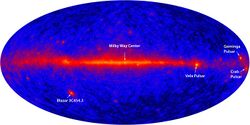3C 454.3
Topic: Astronomy
 From HandWiki - Reading time: 2 min
From HandWiki - Reading time: 2 min
| 3C 454.3 | |
|---|---|
 Fermi-LAT gamma-ray image, including 3C 454.3 | |
| Observation data (Epoch J2000) | |
| Constellation | Pegasus |
| Right ascension | 22h 53m 57.7s[1] |
| Declination | +16° 08′ 53.6″[1] |
| Redshift | 0.859001 ± 0.000170[1] |
| Distance | 7.7 Gly |
| Type | Blazar/Quasar |
| Apparent magnitude (V) | 16.1[1] |
| See also: Quasar,List of quasars]] | |
3C 454.3 is a blazar (a type of quasar with a jet oriented toward Earth) located away from the galactic plane. It is one of the brightest gamma ray sources in the sky,[2] and is one of the most luminous astronomical object ever observed, with a maximum absolute magnitude of -31.4.[3] It has the brightest blazar gamma ray flare recorded, twice as bright as the Vela Pulsar in the Milky Way galaxy. It also flares at radio and visible wavelengths – in red light, the blazar brightened by more than 2.5 times to magnitude 13.7 – and it is very bright at high radio frequencies.[4]
It appears in Pegasus, near Alpha Pegasi (Markab). It has been known to occasionally outburst, brightening to a peak apparent magnitude of 13.4 in June 2014.[5][6]
History
In July and August 2007, the gamma-ray blazar 3C 454.3 flared to near-historic levels, only two years after its record-breaking 2005 optical flare. Luckily, Spitzer Space Telescope and Chandra X-ray Observatory were already scheduled for simultaneous observations. Swift, RXTE and the new gamma-ray AGILE spacecraft responded to this target of opportunity, and were joined by observatories around the world.
The Fermi Large Area Telescope AGN science group started a multiwavelength campaign for blazar 3C454.3 (2251+158), in July and continuing through August 2007. This Ad Hoc Intensive Campaign (AIC) was prompted by brightening in the radio, optical and X-ray.
References
- ↑ 1.0 1.1 1.2 1.3 "3C 454.3". SIMBAD. Centre de données astronomiques de Strasbourg. http://simbad.u-strasbg.fr/simbad/sim-basic?Ident=3C+454.3.
- ↑ Atkinson, Nancy (11 March 2009). "Top Ten Gamma Ray Sources From the Fermi Telescope". http://www.universetoday.com/26831/top-ten-gamma-ray-sources-from-the-fermi-telescope/.
- ↑ "The most luminous quasar state ever observed". Calar Alto Observatory. http://www.caha.es/the-most-luminous-quasar-state-ever-observed.html.
- ↑ "NASA - Fermi Sees Brightest-Ever Blazar Flare". http://www.nasa.gov/mission_pages/GLAST/news/brightest-blazar.html.
- ↑ King, Bob (24 June 2014). "Observing Alert: Distant Blazar 3C 454.3 in Outburst, Visible in Amateur Telescopes". http://www.universetoday.com/112744/observing-alert-distant-blazar-3c-454-3-in-outburst-visible-in-amateur-telescopes/.
- ↑ "Light Curve Generator for 3C 454.3". American Association of Variable Star Observers. http://www.aavso.org/lcg/plot?auid=000-BDC-612&starname=3C+454.3&lastdays=30&start=06/15/2014&stop=&obscode=&obscode_symbol=2&obstotals=yes&calendar=calendar&forcetics=&grid=on&visual=on&uband=on&bband=on&v=on&pointsize=1&width=800&height=450&mag1=&mag2=&mean=&vmean=.
External links
 |
 KSF
KSF